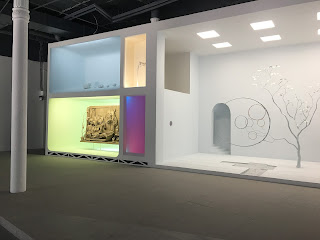That space looks modest-sized now, and far from fancy. A few of the original white columns remain, but little else to recall its golden age. "The Ground" makes an impressive contrast to the plain surroundings. (Tim Smith in the SUN)That is helpful to remember when one enters to see the pop-up use that the Contemporary has installed on the first floor of the "Palace". It is also useful to remember when one considers the future of Howard Street altogether or when one waxes poetic about how glorious the past was. Retail then wasn't any more glorious than a 1956 Packard or a Zenith TV from that time. Not to mention that black people weren't allowed to use the changing rooms.
Hutzler Palace entrance today (photo: ArchPlan)
Change, shifting perspectives, transformation, birth and rebirth; its all in the bright white installation that bisects the former department store floor, the work of New York artist Michael Jones McKean and set up by the Contemporary with a $10k grant from the Downtown Partnership.
It was quite exciting to see the "Palace" doors open again on Saturday night and hundreds of folks that would usually not set foot on Howard Street mill about and explore what the clever installation had to offer.
 |
| Exhibit visitors viewing the art displays (photo: ArchPlan) |
In spite of the somewhat disappointing smallness of the palatial space, it is clear that the building from 1888 architecturally is a bigger star than Hutzler's adjacent building erected almost a hundred years later in a last ditch effort to save the downtown location shortly before the department store closed its doors for good. (There are additional bigger old Hutzler structures north of the Palace, also vacant.
The "Palace" has good bones; it would be extremely unlikely to see a rebirth as a department store, but it could be a lot of other things, at least that is what its owner Deepak Jain thinks who is also the CEO of AiNET and was among the exhibit opening crowd.
AiNET was originally after the unimaginative new Hutzler building at the corner of Lexington Street because it hasn't stood vacant since 1988 but had found a new lease on life as a place that houses switchgear for data lines, the stuff Deepak Jain cares about in his main job. I toured the new Hutzler building once more than ten years back when I investigated the possibility of connecting the Lexington Market metro station with Light Rail on Howard Street through the lower level of the 80s addition. An amazing site, entire floors filled with humming electrical gear that directs and powers low voltage data streams running along Howard Street, reportedly a quarter of the world's Internet data streams. In spite of such prominence in the data flow, Baltimore doesn't offer fiber optic (FIOS) data service. Some recent downtown digging may change the fiber optic diaspora of Baltimore. Jain's interest in the old Palace may bring it back to life for good. Apparently he has set aside $5 million to do that. Ideas will be discussed in the event noted at the bottom.
 |
| the display structure inside the "palace"(photo: ArchPlan) |
Kirby Fowler, never tiring downtown booster was among the guests at the Hutzler show and he was beaming: All the people, the Hippodrome had a show and the Everyman as well. And the AiNET founder which he pointed him out to me alluding to his great ideas what do with the building. Ed Gunts wrote a comprehensive report about the evening and program ideas for future use in the Fishbowl. The SUN wrote a glowing review of the art exhibit itself, so did the Baltimore Magazine. Art fulfilled its role as a pioneer once again.
Klaus Philipsen, FAIA
AiNET and The Contemporary will hold a community forum to discuss ideas for the building and the arts district on March 15, from 5:30 p.m. to 7 p.m., in the street-level exhibit space.
Participants will include Richard Barth, Dean of the University of Maryland’s School of Social Work; Anita Kassoff, executive director of the Baltimore Museum of Industry; Will Holman, the general manager of Open Works, a maker space on Greenmount Avenue; Deepak Jain, AiNET’s founder and president; and representatives from The Contemporary and the Downtown Partnership of Baltimore.
SUN article
Fishbowl Article
 |
| A bit of glitz in the gritty Westside: The Hippdrome as seen from restaurant Forno (photo: Klaus Philipsen) |

I've seen references to linking the subway to the light rail VIA the store. Why was nothing done with that, as it'd help to link the two nodes better than they are now.
ReplyDelete